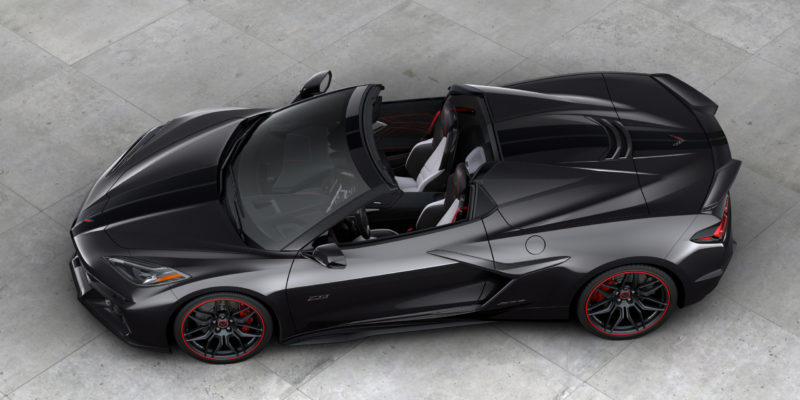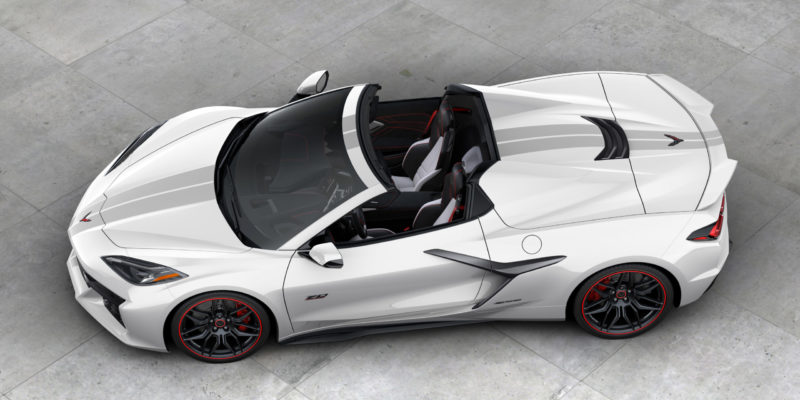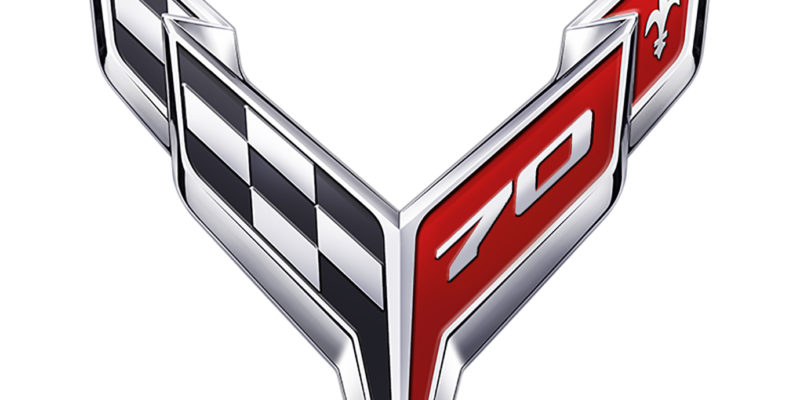Here’s what’s new for the 2024 Corvettes:
Deletions
- 70th Anniversary Package
- Elkhart Lake Blue Metallic
- Caffieine Metallic
Additions
- Riptide Blue Metallic
- Cacti Green
- Sea Wolf Gray Tricoat
- Artemis interior
- (V8X) Visible Carbon Fiber sill plates
- (PCX) Tech Bronze Accent Package: includes Tech Bronze wheels, stealth crossed flag emblem, Jake hood graphic with Tech Bronze accent, Carbon Flash metallic with Tech Bronze accent fender hash marks
- (SL8) Edge Red Rear Corvette script
- (5ZW) Two Stanchion spoiler, visible carbon fiber
- (5DO) 15 Spoke Bright Polished Aluminum wheels
- 5 new Carbon Flash racing stripe options
- (Q9O) 5 Split Spoke Satin Graphite wheels with Machined edge
- (Q9Y) 5 Split Spoke machined face Sterling Silver wheels
- (B6P) Coupe Engine Appearance package= included carbon fiber trim
- (ZZ3) Convertible engine Appearance Package- includes window under tonneau cover and engine cover
- (SIG) Spoiler extension for Z06 & E-Ray models
- (RXI) LT6 engine cover in visible carbon fiber
New Standard Safety Features
- Following distance indicator
- Forward Collision Alert
- Lake Keep Assist with Lane Departure Warning
- Rear Camera mirror standard across all models
- IntelliBeam auto high beam headlights
- Automatic Emergency Braking
- Front Pedestrian Braking
2024 Corvette E-Ray
2023 Corvette Stingray
From front- to mid-engine, in under three seconds
“Corvette has always represented the pinnacle of innovation and boundary-pushing at GM. The traditional front-engine vehicle reached its limits of performance, necessitating the new layout,” said GM President Mark Reuss. “In terms of comfort and fun, it still looks and feels like a Corvette, but drives better than any vehicle in Corvette history. Customers are going to be thrilled with our focus on details and performance across the board.”
The new mid-engine layout gives the Stingray:
- Better weight distribution, with the rear weight bias enhancing performance in a straight line and on the track.
- Better responsiveness and sense of control due to driver positioning closer to the front axle, almost on top of the front wheels.
- The fastest 0-60 time of any entry Corvette ever — under three seconds when equipped with Z51 Performance Package.
- A race car-like view of the road due to lower positioning of the hood, instrument panel and steering wheel. Excellent forward sightlines throughout the vehicle for both driver and passenger.
- An enhancement of Corvette’s traditional utility strengths, with dual trunks for a total of 12.6 cubic feet of cargo volume, ideal for luggage or two sets of golf clubs
Design inspired by racing and aeronautics
The Stingray’s exterior has a bold, futuristic expression with mid-engine exotic proportions, but it is still unmistakably Corvette. It’s lean and muscular, with an athletic sculptural shape conveying a sense of motion and power from every angle.
“As America’s most iconic performance nameplate, redesigning the Corvette Stingray from the ground up presented the team a historic opportunity, something Chevrolet designers have desired for over 60 years,” said Michael Simcoe, vice president of Global Design, General Motors. “It is now the best of America, a new arrival in the mid-engine sports car class. We know Corvette can stand tall with the best the world has to offer.”
A supercar level of craftsmanship, premium materials and attention to detail were critical in designing every component of the Stingray. The new location of the engine is truly the focal point for the car’s design. It’s the heart of this next generation Corvette and it sits like a jewel in a showcase, visible through the large rear hatch window. The added attention to detail optimized the appearance of every wire, tube, bolt and fastener, similar to those found in modern track and all-road motorcycle design.
Some additional design touchpoints include:
- Low profile headlamps designed around all-new projectors.
- Completely hidden door, hood and hatch releases do not disrupt the sculpted design.
- Large side air intakes for engine cooling and aerodynamic performance.
- A-pillar shape that communicates speed and assists in visibility.
- Large rear hatch that showcases the engine with seven air vents.
- Quad exhaust tips located on the vehicle’s outboard ends.
- Dual-element LED taillamps with animated turn signals.
True to its aeronautical and racing roots, the 2020 Stingray’s canopy-forward stance was inspired by F22s, F35s and other modern fighter jets and Formula One racing. Other classic Corvette signatures adapted to the Stingray include a distinctive face that communicates the purpose of the vehicle’s mission, a classic horizontal crease, aggressive front fenders and familiar positioning of the dual-element headlamps.
The interior is further enhanced by:
- A cockpit that has not only migrated forward by 16.5 inches, but envelops the driver, conveying the high performance and aeronautic theme
- Vertical climate controls and ultra-thin vents minimize the height of the instrument panel, creating a low, spacious interior.
- A new, squared-off, two-spoke, small diameter steering wheel that enables an unobscured view of the 12-inch reconfigurable cluster display
The C8 Stingray boasts premium interior materials executed at a high level of quality and craftsmanship:
- Hand-wrapped, cut-and-sew leather components with thick press stitching.
- Generous use of real metal.
- Stainless steel speaker grilles with Bose Performance Series audio system.
- Carbon fiber trim on the GT2 and Competition Sport Seats.
- The choice of either real aluminum or real carbon fiber for console and door trim plates.
Three seat options:
- GT1 – a sporty style that emphasizes comfort while providing good support for performance driving situations. Features Mulan leather trim, optional two-way lumbar support and wing adjustment.
- GT2 – a first for Corvette, these seats have a racing-inspired look with comfort for long trips courtesy of dual density foam. They include carbon fiber trim, a Napa leather insert, Mulan leather bolsters, a jet black-painted seat back, two-way lumbar support and wing adjustment, plus heating and ventilation.
- Competition Sport – designed for the serious track-focused driver, these seats include aggressive bolsters, full Napa seating surfaces and carbon fiber trim on the headrest, heating and ventilation, along with an all-new durable performance textile inspired by Kevlar vests.
Engineered to be a true supercar for every day
Corvette’s structure is built around its backbone: the center tunnel. This enables a light, stiff structure to serve as the foundation for the suspension system to perform in an optimized manner. By removing unwanted body compliance, Corvette customers will experience the ultimate in ride performance with outstanding lateral grip capabilities. The car has a solid, connected-to-the-road feel with minimal vibrations at high speeds or on long road trips.
“Our mission was to develop a new type of sports car, combining the successful attributes of Corvette with the performance and driving experience of mid-engine supercars,” said Tadge Juechter, Corvette executive chief engineer.
The tunnel-dominant approach offers many advantages, including:
- Improved torsional rigidity with a solid, connected feel on both the road and track.
- Outstanding ingress/egress for a mid-engine vehicle. Unlike some competitors, there’s no need for oversized rocker panels to bear structural and load weights, making it easier to enter and exit the vehicle.
- Excellent stability due to a low center of gravity and outstanding handling.
- Preservation of Corvette’s beloved standard removable roof panel, which can easily be stored in the rear trunk.
- A front storage compartment that can fit an airline-spec carry-on and a laptop bag.
- Availability in both left- and right-hand-drive variants — a first for Corvette.
- Smart packaging with improved cabin comfort, including an additional inch of rearward seat travel and almost double the reclining angle.
The all-new Corvette Stingray is built with a smart mixed-materials strategy, enabling key features such as:
- A strong, stiff and lightweight main structure of six high-pressure diecast aluminum parts, also known as the Bedford Six, which are manufactured at GM Powertrain in Bedford, Indiana. These minimize the number of joints within the vehicle, making a stiffer structure that aids in handling and track cornering.
- Industry-first carbon fiber curved rear bumper beam for weight reduction.
- Front and rear trunk tubs and dashboard molded from ultra-lightweight “float” derived from fiberglass and a proprietary resin. The material is so light that it can actually float in water. It works with other fiberglass and carbon fiber variants to lower mass and reduce noise and vibration.
Handling: core to Corvette’s fun-to-drive DNA
The Stingray is designed for superior ride comfort on the highway and well-balanced handling on the track.
“Thanks to sophisticated suspension geometry, tailored tire technology and exquisite attention to structural details, we have improved ride and handling,” said Juechter. “No Corvette has ever felt so comfortable, nimble and yet completely stable.”
The new Stingray features coil over dampers that create entirely new ride and handling characteristics. The mid-engine architecture allows for a short, straight and stiff steering system, coupled with an updated electronic steering system, making the driver’s chassis input instantaneous.
The new seating position places the car’s center of gravity close to the driver’s inside hip, so the car literally turns around the driver. It completely changes the perception of vehicle handling and responsiveness.
Other ride and handling upgrades include:
- Steering ratio improved from 16.25:1 to 15.7:1.
- New eBoost brakes that are more precise and tunable.
- The first sports car application of Michelin’s all-season performance tire that can corner at nearly 1G.
- Front suspension lift that raises ground clearance by approximately 40mm at the front bumper in 2.8 seconds, protecting against bumps, potholes, steep driveways and other road disturbances. It can operate at speeds up to 24 mph and be programmed to work automatically through GPS to remember up to 1,000 locations.
- Launch control aided by the rear weight distribution, enabling the new Stingray to get off the line quicker than any Corvette in history.
- Z51 Performance Package, which introduces a host of new technology to the 2020 Stingray:
• Performance suspension with manually adjustable threaded spring seats.
• Larger brake rotors with Z51 logo on calipers.
• Enhanced cooling.
• Specific axle ratio.
• Front brake cooling inlets.
• Performance exhaust.
- An electronic limited slip differential integrated into the transaxle that modulates torque between the rear tires, enabling incredible vehicle stability.
- A front splitter and open two-piece rear spoiler that add up to a combined 400 pounds of downforce while improving grip when cornering.
- Available Magnetic Ride Control 4.0, which reads the road better, providing more precise data through suspension-mounted accelerometers. Its improved electronics respond faster and more smoothly to driver inputs and contribute to class-leading ride quality.
- Available Performance Traction Management.
The jewel in the center
The Stingray’s heart is Chevy’s next-generation 6.2L Small Block V-8 LT2 engine, the only naturally aspirated V-8 in the segment. It will produce 495 horsepower (369 kW) and 470 lb-ft (637 Nm) of torque when equipped with performance exhaust — the most horsepower and torque for any entry Corvette.
“Though now placed behind the driver, the LT2 gives the same visceral experience we all expect from Corvette,” said Jordan Lee, GM’s global chief engineer of Small Block engines. “The LT2 has been designed to deliver excellent low-end torque and high-end power to give thrilling pedal response at any RPM.”
The powertrain’s low position enables a low center of gravity for optimal handling. Perhaps the biggest update is found in the lubrication and ventilation system. For the first time ever, the base Stingray will use an engine-mounted dry sump oil system and three scavenge pumps for improved track performance.
During serious track driving, oil volume remains high to avoid diminished performance. The new Stingray’s lateral capability is greatly improved, so the LT2’s dry sump lubrication system had to be redesigned to provide exceptional engine performance even at lateral acceleration levels exceeding 1G in all directions.
A lightweight, 3.2mm-thick glass panel on the rear hatch allows owners to show off the engine. This panel features a cantilevered trailing edge to evacuate heat from the LT2 engine compartment.
Other notable engine characteristics include:
- Jewel-like setting in the rear compartment, visible through the rear glass hatch.
- Every part, including the exhaust system’s wires, tubes, routing fasteners, coolant hoses, exhaust manifold and even the bolts and fasteners, is built with appearance in mind. All engine components were given careful consideration just like the exterior, and even the heat shields are textured.
- A brand-new block and vent system. The centerline of the crankshaft sits an inch lower to the ground where it mates to the transaxle for better handling.
- Low-profile oil pan that reduces mass.
- Oil cooler capacity increased by 25 percent.
- Standard edge Red valve covers.
A shift of a different kind
The next generation LT2 is paired with Chevrolet’s first eight speed dual-clutch transmission, which provides lightning-fast shifts and excellent power transfer. This transmission is uniquely designed with TREMEC to provide the best of both worlds: the spirited, direct connected feeling of a manual and the premium driving comfort of an automatic. The double-paddle de-clutch feature even allows the driver to disconnect the clutch by holding both paddles for more manual control.
Paddle shifters allow drivers to choose a specific gear. “The performance shift algorithms are so driver-focused, they can sense when you’re doing spirited driving — regardless of driving mode — and will hold lower gears longer for more throttle response,” said Juechter.
The new Small Block V-8 has a torque curve optimized to take advantage of the bespoke DCT’s lightning-fast shifts. Engineers set the DCT up with a very low first gear to leverage the additional traction to get the car off the line quickly, and its close-ratio gears 2 through 6 keep the engine near the power peak on track. Tall seventh and eighth gears make for easy long-distance cruising with low mechanical stress and excellent fuel economy.
The DCT is mated to a new Electronic Transmission Range Selector. With this electric shifter there’s no mechanical interface between the shift lever and the transmission. The Corvette’s electric shifter incorporates two pull toggles for Reverse and Drive and push buttons for Park, Neutral and Low/Manual. The shifter has been designed to be more attractive and compact than a standard shifter.
All-new technology improves performance and usability
Driver mode choices have been expanded from four to six, allowing drivers to tweak the feel of their Corvettes to their personal preference. The familiar Weather, Tour, Sport and Track modes remain, and there are two new modes:
- MyMode, a configurable setting for preferred driving style that can remain between key cycles.
- Z mode, named after the famed Z06, ZR1 and Z51 Corvette performance packages, is activated through a “Z” button on the steering wheel. This is a single-use mode that takes MyMode configurations one step further, allowing drivers to adjust the engine and transmission as well.
The Stingray benefits from GM’s new digital vehicle platform, an all-new electronic architecture that enables the adoption of the company’s next generation of technologies. The architecture minimizes wiring while allowing for faster signal transmission between different vehicle systems and the higher resolution screens. The platform enables continuous vehicle improvements through over-the-air updates and enhanced cybersecurity measures.
Other new technology features include:
- Corvette’s next-generation infotainment system is faster and simpler, with a higher resolution display.
- Chevy-first one-touch Bluetooth pairing with Near Field Communication.
- Wireless charging.
- Learn-as-you-go voice recognition.
- Improved real-time traffic.
- A new, 12-inch customizable instrument cluster tailored to all six driver modes.
New electrical features include:
- Driver and passenger seat memory.
- Heated steering wheel.
- Tire fill alert warns the driver when tire meets maximum pressure.
- Two new Bose audio systems: a 10-speaker standard premium system and available 14-speaker Bose Performance Series system. Speaker grilles are integrated into lower door trim for a refined look that also helps guard against damage from footwear.
Source: Chevrolet
- The industry-pioneering Performance Data Recorder, an advanced driving analysis tool upgraded with high-definition resolution camera and a new, in-vehicle user interface. Customers can record both circuit and point-to-point road courses. The PDR can be set to auto-record like a dash cam that starts a recording every time the Corvette is running, or configured to only start when the car is set to Valet mode.







